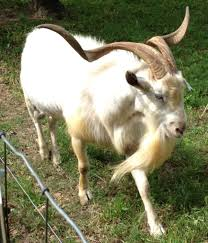Type the name of the breed you're looking for below
[wpdreams_ajaxsearchlite] Don't see the breed your're looking for? Click here and let us know!
Kiko goat
| Place of Origin | New Zealand |
| Origin | The Kiko goat was developed firstly by Caprinex Enterprises Limited and later by Goatex Group Limited, New Zealand companies responsible for the breeding of Kiko goats in New Zealand. These companies of farmers were actively involved in the capture and farming of New Zealand's extensive feral goat population. All members had a vigorous and ongoing interest in meat production as a consequence of which several thousand of the most substantial and fertile native goats were screened into a breeding program in which population dynamics was rigorously applied to produce a goat with enhanced meat production ability under difficult management conditions. The appropriately named Kiko goat was purpose-bred in New Zealand for meat production – the Maori word “kiko” meaning flesh or meat. In New Zealand Māori, the Polynesian language spoken by the Māori people, 'kikokiko' is the generic term for flesh for consumption. Caprinex Entrprises Ltd, the New Zealand originators of the breed used "kiko" to describe the enhanced meat producing goat they were developing. The developers of the breed were Garrick and Anne Batten of Nelson in the northern South Island, and they developed the Kiko from feral goats that had been liberated or had escaped over the last hundred years or so of European settlement. These feral goats could be found in many places throughout the country, and although they were hardy, they were relatively small and produced little meat or milk. The Kiko breed was established by crossbreeding selected feral does with Anglo-Nubian, Toggenburg and Saanen bucks, with further cross-breeding in the second and third generations. After four generations of selective breeding – selection being on the grounds of survivability and growth rate in a hill country environment – a dramatic improvement in liveweight and animal performance was achieved. By 1986 the Kiko breed was established and the herd was closed to further cross-breeding. Within New Zealand, control of the breed has remained with the original developers. However, Kikos were exported to the United States in the 1990s, and there are now a number of enthusiastic breeders of Kikos in that country. |
| Purpose | Meat |
| Characteristics | Interest continues to increase in the consistent traits and characteristics of Kiko goats. Whether raised Kiko on Kiko, or crossed with other breeds, Kikos bring improvement in profits because of their low maintenance, high rate of growth, resistance and tolerance to parasites, excellent maternal instincts, ease of kidding, vigor of newborn kids, and because of the incorporation of milk breeds in the creation of Kiko, an ample milk supply to raise twins that gain quickly to earlier sale weights. |



